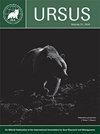Influence of maternal body size, condition, and age on recruitment of four brown bear populations
IF 0.6
4区 生物学
Q4 ZOOLOGY
引用次数: 4
Abstract
Abstract: Recruitment of brown bear (Ursus arctos) offspring into a population is the product of initial cub production and subsequent survival and is a critical component of overall population status and trend. We investigated the relationship between maternal body size, body condition, and age (as a surrogate for gained experience) and recruitment of dependent offspring (≥1 yr old) in 4 Alaska, USA (2014–2017), brown bear populations using logistic regression. Body size alone was our top predictor of the presence of offspring and appeared in all top models. Our data suggest that bear size is the primary driver of productivity across all 4 study populations, with larger bears having a greater chance of being observed with offspring. The effect of body condition was likely confounded by the increased energetic costs of supporting cubs through time and had a negative relationship with recruitment. Age (experience) was positively related to recruitment. Understanding the relative importance of body size, body condition, and age on the recruitment of offspring provides insights into life-history trade-offs female bears must manage as they strive to meet the nutritional costs of cub production and rearing, while minimizing risks to themselves and their offspring. Further assessment of long-term longitudinal studies of brown bears that assess the lifetime reproductive output of individuals would be highly informative to further assess the effect of experience on recruitment and to support the management of brown bear populations for recovery, conservation, sustained yield, and ecosystem function.母熊体型、状况和年龄对四种棕熊种群招募的影响
摘要:棕熊(Ursus arctos)后代的补充是种群初始幼崽生产和后续生存的产物,是种群整体状况和趋势的重要组成部分。在美国阿拉斯加州(2014-2017)的4个棕熊种群中,我们使用logistic回归研究了母熊体型、身体状况和年龄(代替获得的经验)与抚养后代(≥1岁)的关系。体型本身是我们预测后代存在的最重要因素,并且出现在所有顶级模特身上。我们的数据表明,在所有4个研究种群中,熊的体型是生产力的主要驱动因素,体型较大的熊有更大的机会被观察到有后代。随着时间的推移,身体状况的影响可能与抚养幼崽的能量成本增加相混淆,并且与招募呈负相关。年龄(经验)与招聘呈正相关。了解体型、身体状况和年龄对后代招募的相对重要性,有助于了解母熊在努力满足幼崽生产和抚养的营养成本,同时最大限度地减少对自己和后代的风险时必须进行的生活史权衡。进一步评估棕熊的长期纵向研究,评估个体的终身生殖产出,将为进一步评估经验对招募的影响提供大量信息,并为棕熊种群的恢复、保护、持续产量和生态系统功能的管理提供支持。
本文章由计算机程序翻译,如有差异,请以英文原文为准。
求助全文
约1分钟内获得全文
求助全文
来源期刊

Ursus
生物-动物学
CiteScore
2.00
自引率
15.40%
发文量
12
审稿时长
>12 weeks
期刊介绍:
Ursus includes a variety of articles on all aspects of bear management and research worldwide. Original manuscripts are welcome. In addition to manuscripts reporting original research, submissions may be based on thoughtful review and synthesis of previously-reported information, innovative philosophies and opinions, and public policy or legal aspects of wildlife conservation. Notes of general interest are also welcome. Invited manuscripts will be clearly identified, but will still be subject to peer review. All manuscripts must be in English. All manuscripts are peer-reviewed, and subject to rigorous editorial standards.
 求助内容:
求助内容: 应助结果提醒方式:
应助结果提醒方式:


